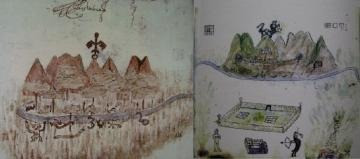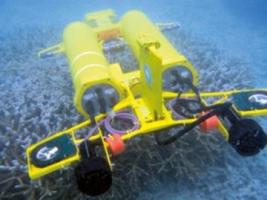Copy Link
Add to Bookmark
Report
Public-Access Computer Systems Review Volume 03 Number 02

+ Page 1 +
-----------------------------------------------------------------
The Public-Access Computer Systems Review
Volume 3, Number 2 (1992) ISSN 1048-6542
-----------------------------------------------------------------
To retrieve an article file as an e-mail message, send the GET
command given after the article information to LISTSERV@UHUPVM1
(BITNET) or LISTSERV@UHUPVM1.UH.EDU (Internet). To retrieve the
article as a file, omit "F=MAIL" from the end of the GET command.
CONTENTS
COMMUNICATIONS
The Development of a Graphical User Interface for The Online
Journal of Current Clinical Trials
By Thomas B. Hickey and Terry Noreault (pp. 4-12)
To retrieve this file: GET HICKEY PRV3N2 F=MAIL
Electronic Publishing on Networks: A Selective Bibliography of
Recent Works
By Charles W. Bailey, Jr. (pp. 13-20)
To retrieve this file: GET BAILEY PRV3N2 F=MAIL
COLUMNS
Recursive Reviews
Artificial Intelligence, Libraries, and Information
Retrieval
By Martin Halbert (pp. 21-28)
To retrieve this file: GET HALBERT PRV3N2 F=MAIL
REVIEWS
Library Resources on the Internet: Strategies for Selection and
Use
Reviewed by Caroline R. Arms (pp. 29-34)
To retrieve this file: GET ARMS PRV3N2 F=MAIL
+ Page 2 +
-----------------------------------------------------------------
The Public-Access Computer Systems Review
Editor-in-Chief
Charles W. Bailey, Jr.
University Libraries
University of Houston
Houston, TX 77204-2091
(713) 743-9804
LIB3@UHUPVM1 (BITNET) or LIB3@UHUPVM1.UH.EDU (Internet)
Associate Editors
Columns: Leslie Pearse, OCLC
Communications: Dana Rooks, University of Houston
Reviews: Roy Tennant, University of California, Berkeley
Editorial Board
Ralph Alberico, University of Texas, Austin
George H. Brett II, University of North Carolina
General Administration
Steve Cisler, Apple
Walt Crawford, Research Libraries Group
Lorcan Dempsey, University of Bath
Nancy Evans, Pennsylvania State University, Ogontz
Charles Hildreth, READ Ltd.
Ronald Larsen, University of Maryland
Clifford Lynch, Division of Library Automation,
University of California
David R. McDonald, Tufts University
R. Bruce Miller, University of California, San Diego
Paul Evan Peters, Coalition for Networked Information
Mike Ridley, University of Waterloo
Peggy Seiden, Pennsylvania State University, New Kensington
Peter Stone, University of Sussex
John E. Ulmschneider, North Carolina State University
Publication Information
Published on an irregular basis by the University Libraries,
University of Houston. Technical support is provided by the
Information Technology Division, University of Houston.
Circulation: 4,130 subscribers in 45 countries (PACS-L) and 314
subscribers in 27 countries (PACS-P).
+ Page 3 +
Back issues are available from LISTSERV@UHUPVM1 (BITNET) or
LISTSERV@UHUPVM1.UH.EDU (Internet). To obtain a list of all
available files, send the following e-mail message to the
LISTSERV: INDEX PACS-L. The name of each issue's table of
contents file begins with the word "CONTENTS."
-----------------------------------------------------------------
-----------------------------------------------------------------
The Public-Access Computer Systems Review is an electronic
journal that is distributed on BITNET, Internet, and other
computer networks. There is no subscription fee.
To subscribe, send an e-mail message to LISTSERV@UHUPVM1
(BITNET) or LISTSERV@UHUPVM1.UH.EDU (Internet) that says:
SUBSCRIBE PACS-P First Name Last Name. PACS-P subscribers also
receive two electronic newsletters: Current Cites and Public-
Access Computer Systems News.
The Public-Access Computer Systems Review is Copyright (C)
1992 by the University Libraries, University of Houston. All
Rights Reserved.
Copying is permitted for noncommercial use by computer
conferences, individual scholars, and libraries. Libraries are
authorized to add the journal to their collection, in electronic
or printed form, at no charge. This message must appear on all
copied material. All commercial use requires permission.
-----------------------------------------------------------------
+ Page 29 +
-----------------------------------------------------------------
The Public-Access Computer Systems Review 3, no 2 (1992): 29-34.
-----------------------------------------------------------------
-----------------------------------------------------------------
Farley, Laine, ed. Library Resources on the Internet: Strategies
for Selection and Use. Chicago: American Library Association,
1992. ISBN 0-8389-7576-3. Reviewed by Caroline R. Arms.
-----------------------------------------------------------------
Take this guide with you next time you set out for a trip to
explore some online catalogs on the Internet highway. Library
Resources on the Internet was developed by the ALA/RASD/MARS
committee on Direct Patron Access to Computer-Based Reference
Systems. It "seeks to give users practical strategies for
identifying and using one type of resource--library catalogs on
the Internet." It is also a kit of sections that can be
modified, updated, and reassembled into a more specific handout
for a particular library or as the basis for a training session.
Knowing that their committee was to be reorganized out of
existence, the authors wisely chose to concentrate on the aspects
of the Internet where their librarian's training and experience
would provide most added value and to rely on providing pointers
to existing directories of catalogs and other "road maps" that
were more likely to be updated. One thing that sets this guide
apart from other documents related to catalogs on the Internet
are the pointers to "travel guides," resources that may help a
patron decide which remote catalogs would be appropriate to
search.
The authors' metaphor of maps and travel guides builds on
the widely used analogy between the Internet and the highway
system. It evokes images of Rand McNally road atlases, of
Michelin travel guides that rate the hotels and restaurants and
suggest scenic routes, and of the AAA, ready to prepare an
itinerary for you and help you if you get lost or have an
accident. Perhaps the metaphor is worth pursuing. Setting out
on a vacation in unfamiliar territory, you would usually take
both a road map and a travel guide. In the new "wired"
information infrastructure, there will be a need not only for
formal catalogs of resources (road maps), but also for travel
guides that give you information about the local culture and
conventions, suggest routes or tours, evaluate restaurants, and
describe museums. Travel guides vary widely, and you can choose
one that suits you; you may prefer Europe on $25 Dollars a Day to
the Michelin guide. Developing such guides to resources on the
Internet (or the National Research and Education Network) could
be an important role for librarians. This guide takes a step in
the right direction.
+ Page 30 +
Current guides to the Internet, however excellent, often
give the impression that the Internet is only for the intrepid
and self-sufficient individual. The very titles of two of the
most popular, The Hitchhiker's Guide to the Internet and Zen and
the Art of the Internet, confirm that impression. Library
Resources on the Internet is different. This guide is not
written for computer experts or network hackers. Nor does it
make the assumption that the only source of information is the
network itself. It points out that, if you want access to the
Internet, your starting-point should be your local computer
network support organization. This point could even be stressed
more; the Internet is a network of networks, and the network
through which you have access has a responsibility to facilitate
that access. Whether your connection is through an academic
institution or one of the commercial operations that now offer
access to the Internet, you can usually get help from the
supplier of that connection with basic telecommunications
procedures, including recommendations for acquiring and
configuring software. Like your car dealer, the network supplier
can give you the basic owner's manual and check whether the
vehicle works, at least using the software they recommend.
Once you have a connection to the Internet and know how to
connect to a remote computer, you need a different level of
assistance: help selecting the resources that will be of most
value to you and guidance in the use of those resources. Library
Resources on the Internet provides this type of assistance for
people interested in exploring the increasing number of online
catalogs accessible over the Internet. In a relaxed, non-
technical style, it presents a variety of information directly,
and it describes other important tools for the explorer's kit.
It begins with a brief introduction to the Internet and a list of
possible reasons for searching remote catalog systems. Then
comes a section on other road maps and travel guides, followed by
tips on using online catalogs effectively. The last section is a
description of related resources, with examples of campus-wide
information systems and specialized databases that are not part
of online catalog systems. Finally come four appendices: a
bibliography of articles that address use of the Internet for
public services in libraries; a very useful introduction to
searching the catalogs of the most widely installed library
systems; a glossary of networking terms; and a primer on the use
of the Internet file transfer protocol, FTP.
+ Page 31 +
The guide pulls together a variety of information relating
to the use of online catalogs in a single document. Naturally,
some material is presented in a brief, introductory fashion,
setting the context rather than presenting a full explanation.
Topics that may be important for future developments, such as
Z39.50, the standard protocol for information retrieval, and
Z39.58, the Common Command Language, are introduced in
appropriate contexts. The authors have succeeded in their aim of
providing a practical guide that serves both the user who wants
to explore online catalogs on the Internet and librarians who are
trying to get a broader picture of how the accessibility of
library resources on the Internet may change their world.
Two of the central sections are particularly valuable
because they are not duplicated elsewhere. The first covers
existing road maps and travel guides. The road maps include the
directories of online catalogs and other network resources, such
as the catalog lists maintained by Art St. George at the
University of New Mexico and Billy Barron at the University of
North Texas as well as the Internet Resource Guide. Databases
and software packages that facilitate access to remote catalogs
are also described. Participants in the PACS-L discussion group
will have seen most of the items mentioned regularly. However,
when it comes to the travel guides, there may be some unfamiliar
suggestions. Not surprisingly, given its authorship, the guide
suggests that you ask a reference librarian for help in
identifying library collections with strengths in your area of
interest. For those to whom talking to a live reference
librarian would be painful, it includes some print directories
that either describe collection strengths explicitly or list
university doctoral programs that suggest areas of emphasis. It
is refreshing to be reminded that not all information about
network resources is on the network itself. At the end of this
section is a brief discussion of gateways, such as the CARL
(Colorado Alliance of Research Libraries) system, and
client/server systems, such as WAIS (Wide Area Information
Server). The whole section is sprinkled with useful tips and
caveats.
+ Page 32 +
The other particularly valuable section, "Using Systems
Successfully--Survival Tips," is entirely tips and caveats.
Instructions and hints on using TELNET for connecting to the
remote catalogs are presented in a non-technical way that is not
specific to any particular type of computer. The tips on
searching catalogs may seem self-evident to librarians used to
searching online systems, but they are ideal for novice or
occasional searchers. They range from "Read the SCREENS" to
suggestions for identifying appropriate subject terms and for
broadening and narrowing searches. Referred to in conjunction
with the appendix of catalog interfaces from commercial systems,
this section alone would save a great deal of frustration for
librarians and end users.
The authors explicitly designed the guide as a source of
material for others to incorporate into their own documentation
or instructional handouts, provided that the source is duly
credited and the use is noncommercial. As it stands, the guide
could be handed to a patron who already knows how to log on to a
remote computer on the Internet, but has had difficulty using a
remote catalog or wants to determine which catalogs might have
good collections in the patron's field of interest. To make a
complete travel kit, select some sections (updating where
appropriate), replace others with details appropriate for your
local environment (such as telecommunication procedures), and
package them with one of the lists of online catalogs that it
suggests. You may want to involve computer services staff in
preparing the package and making it and some of the related
documents or software available online. At the very least, I
strongly encourage academic libraries to make sure that computing
services staff in their institution have a copy of this guide for
their own use and as a resource for user consultants.
The guide is available in print as an occasional paper of
the Reference and Adult Services Division of the ALA. It is also
available online for anonymous FTP retrieval. It has also been
transformed into an interactive, hypertext form by Ernest Perez,
formerly Library Director of the Houston Chronicle and the
Chicago Sun-Times. This version is also available online for
anyone to retrieve and run on a personal computer that uses the
DOS operating system. Although I thoroughly recommend reading
through the entire document, the hypertext version will suit some
people very well for later reference. The online version of the
document states that it will remain in its original location
(DLA.UCOP.EDU, see below) "until it is obviously out of date or
until it has a successor." I certainly hope for the second
outcome. As is always the case, some of the material is already
out of date, but only in very minor ways. This guide deserves to
be kept up to date and available so that both librarians and end-
users can take enjoyable and profitable trips to visit catalogs
on the Internet.
+ Page 33 +
How to Obtain This Document
Print:
o American Library Association as RASD Occasional Paper
no. 12; $18 for ALA members, $20 for non-members.
Anonymous FTP:
ASCII file:
o Host: DLA.UCOP.EDU; directory: pub/internet; file name:
libcat-guide.
o Host: HYDRA.UWO.CA; directory: libsoft; file name:
libcat.txt.
o Host: FTP.UNT.EDU; directory: library; file name:
libcat-guide.
WordPerfect 5.1 file:
o Host: HYDRA.UWO.CA; directory: libsoft; file name:
internet.com.
Self-Extracting executable hypertext file:
o Host: HYDRA.UWO.CA; directory: libsoft; filenames:
libinet.exe and libinet.doc.
o Host: FTP.UNT.EDU; directory: library; file names:
libinet.exe and libinet.doc
About the Author
Caroline R. Arms, Head, Microcomputer & Media Center, Falk
Library of the Health Sciences, University of Pittsburgh.
Internet: cra@med.pitt.edu.
+ Page 34 +
-----------------------------------------------------------------
The Public-Access Computer Systems Review is an electronic
journal that is distributed on BITNET, Internet, and other
computer networks. There is no subscription fee.
To subscribe, send an e-mail message to LISTSERV@UHUPVM1
(BITNET) or LISTSERV@UHUPVM1.UH.EDU (Internet) that says:
SUBSCRIBE PACS-P First Name Last Name. PACS-P subscribers also
receive two electronic newsletters: Current Cites and Public-
Access Computer Systems News.
This article is Copyright (C) 1992 by Caroline R. Arms. All
Rights Reserved.
The Public-Access Computer Systems Review is Copyright (C)
1992 by the University Libraries, University of Houston. All
Rights Reserved.
Copying is permitted for noncommercial use by computer
conferences, individual scholars, and libraries. Libraries are
authorized to add the journal to their collection, in electronic
or printed form, at no charge. This message must appear on all
copied material. All commercial use requires permission.
-----------------------------------------------------------------
+ Page 13 +
-----------------------------------------------------------------
Bailey, Charles W., Jr. "Electronic Publishing on Networks: A
Selective Bibliography of Recent Works." The Public-Access
Computer Systems Review 3, no. 2 (1992): 13-20.
-----------------------------------------------------------------
1.0 Introduction
Despite a variety of problems, electronic publishing on BITNET,
Internet, and other networks is experiencing vigorous growth as
scholars experiment with FTP archives, list servers, WAIS
servers, and other technological tools in order to reinvent
scholarly publishing.
This bibliography presents selected sources, in both paper
and electronic form, that are useful in understanding network-
based electronic publishing. A limited number of sources that
deal with broader electronic publishing topics, such as
intellectual property rights, multimedia systems, standards, and
virtual libraries, are also included; however, this bibliography
does not provide an in-depth treatment of the large and diverse
body of literature that deals with electronic publishing as a
whole. In order to focus on recent developments, it does not
cover sources published prior to 1989 (most sources are from 1990
to the present).
Hopefully, this bibliography will introduce interested
readers to sources that will provide them with insight into the
incredible intellectual ferment associated with network-based
electronic publishing.
2.0 Bibliography
Alexander, Adrian W., and Julie S. Alexander. "Intellectual
Property Rights and the 'Sacred Engine': Scholarly Publishing in
the Electronic Age." Advances in Library Resource Sharing 1
(1990): 176-192.
Amiran, Eyal, Elaine Orr, and John Unsworth. "Refereed
Electronic Journals and the Future of Scholarly Publishing."
Advances in Library Automation and Networking 4 (1991): 25-53.
Amiran, Eyal, and John Unsworth. "Postmodern Culture: Publishing
in the Electronic Medium." The Public-Access Computer Systems
Review 2, no. 1 (1991): 67-76. (To retrieve this article, send
an e-mail message that says "GET AMIRAN PRV2N1 F=MAIL" to
LISTSERV@UHUPVM1 or LISTSERV@UHUPVM1.UH.EDU.)
Arms, William Y. "Scholarly Publishing on the National
Networks." Scholarly Publishing 23 (April 1992): 158-169.
+ Page 14 +
Bailey, Charles W., Jr. "The Coalition for Networked
Information's Acquisition-on-Demand Model: An Exploration and
Critique." Serials Review 18, nos. 1-2 (1992): 78-81.
Bailey, Charles W., Jr. "Electronic (Online) Publishing in
Action . . . The Public-Access Computer Systems Review and Other
Electronic Serials." ONLINE 15 (January 1991): 28-35.
Bailey, Charles W., Jr. "Intelligent Multimedia Computer
Systems: Emerging Information Resources in the Network
Environment." Library Hi Tech 8, no. 1 (1990): 29-41.
Bailey, Charles W., Jr. "Network-Based Electronic Serials."
Information Technology and Libraries 11 (March 1992): 29-35.
Bailey, Charles W., Jr., and Dana Rooks, eds. "Symposium on the
Role of Network-Based Electronic Resources in Scholarly
Communication and Research." The Public-Access Computer Systems
Review 2, no. 2 (1991): 4-60. (To retrieve this article, send an
e-mail message that says "GET BAILEY1 PRV2N2 F=MAIL" to
LISTSERV@UHUPVM1 or LISTSERV@UHUPVM1.UH.EDU.)
Basch, Reva. "Books Online: Visions, Plans, and Perspectives for
Electronic Text." ONLINE 15 (July 1991): 13-23.
Beazley, William G. "Impact of CALS on Electronic Publishing
Systems and Users." Library Trends 38 (Spring 1990): 799-815.
Brown, Heather. "Standards for Structured Documents." The
Computer Journal 32, no. 6 (1989): 505-514.
Bulick, Stephen. "Future Prospects for Network-Based Multimedia
Information Retrieval." The Electronic Library 8 (April 1990):
88-99.
Butler, Brett. "Electronic Editions of Serials: The Virtual
Library Model." Serials Review 18, nos. 1-2 (1992): 102-106.
Butler, Brett. "The Electronic Library Program: Developing
Networked Electronic Library Collections." Library Hi Tech 9,
no. 2 (1991): 21-30.
Cisler, Steve. "Convergent Electronic Cultures." Serials Review
18, nos. 1-2 (1992): 55-57.
Cline, Nancy. "Information Resources and the National Network."
EDUCOM Review 25 (Summer 1990): 30-34.
+ Page 15 +
Dempsey, Lorcan. Libraries, Networks and OSI: A Review, with a
Report on North American Developments. Bath, England: U.K.
Office for Library Networking, the Library, University of Bath,
1991.
Dertouzos, Michael L. "Building the Information Marketplace."
Technology Review 94 (January 1991): 29-40.
Drake, Miriam. "Buying Articles in the Future." Serials Review
18, nos. 1-2 (1992): 75-77.
Duggan, Mary Kay. "Copyright of Electronic Information: Issues
and Questions." ONLINE 15 (May 1991): 20-26.
Garcia, Linda D. "Information Exchange: The Impact of Scholarly
Communication." EDUCOM Review 25 (Fall 1990): 28-32.
Gardner, William. "The Electronic Archive: Scientific Publishing
for the 1990s." Psychological Science 1 (November 1990): 333-
341.
Getz, Malcolm. "Electronic Publishing: An Economic View."
Serials Review 18, nos. 1-2 (1992): 25-31.
Grycz, Czeslaw Jan. "Economic Models for Networked Information."
Serials Review 18, nos. 1-2 (1992): 11-18.
Hall, Stephen C. "The Four Stages of National Research and
Education Network Growth." EDUCOM Review 26 (Spring 1991): 18-
25.
Harnad, Stevan. "Interactive Publication: Extending the American
Physical Society's Discipline-Specific Model for Electronic
Publishing." Serials Review 18, nos. 1-2 (1992): 58-61.
Harnad, Stevan. "Post-Gutenberg Galaxy: The Fourth Revolution in
the Means of Production of Knowledge." The Public-Access
Computer Systems Review 2, no. 1 (1991): 39-53. (To retrieve
this article, send an e-mail message that says "GET HARNAD PRV2N1
F=MAIL" to LISTSERV@UHUPVM1 or LISTSERV@UHUPVM1.UH.EDU.)
Harnad, Stevan. "Scholarly Skywriting and the Prepublication
Continuum of Scientific Inquiry." Psychological Science 1
(November 1990): 342-344.
+ Page 16 +
Harrison, Teresa M., Timothy Stephen, and James Winter. "Online
Journals: Disciplinary Designs for Electronic Scholarship." The
Public-Access Computer Systems Review 2, no. 1 (1991): 25-38.
(To retrieve this article, send an e-mail message that says "GET
HARRISON PRV2N1 F=MAIL" to LISTSERV@UHUPVM1 or
LISTSERV@UHUPVM1.UH.EDU.)
Hart, Michael S. "Project Gutenberg: Access to Electronic
Texts." Database 13 (December 1990): 6-9.
Hickey, Thomas B., and Terry Noreault. "The Development of a
Graphical User Interface for The Online Journal of Current
Clinical Trials." The Public-Access Computer Systems Review 3,
no. 2 (1992): 4-12. (To retrieve this article, send an e-mail
message that says "GET HICKEY PRV3N2 F=MAIL" to LISTSERV@UHUPVM1
or LISTSERV@UHUPVM1.UH.EDU.)
Hugo, Jane, and Linda Newell. "New Horizons in Adult Education:
The First Five Years (1987-1991)." The Public-Access Computer
Systems Review 2, no. 1 (1991): 77-90. (To retrieve this
article, send an e-mail message that says "GET HUGO PRV2N1
F=MAIL" to LISTSERV@UHUPVM1 or LISTSERV@UHUPVM1.UH.EDU.)
Jennings, Edward M. "EJournal: An Account of the First Two
Years." The Public-Access Computer Systems Review 2, no. 1
(1991): 91-110. (To retrieve this article, send an e-mail
message that says "GET JENNINGS PRV2N1 F=MAIL" to
LISTSERV@UHUPVM1 or LISTSERV@UHUPVM1.UH.EDU.)
Jensen, Mary Brandt. "Making Copyright Work in Electronic
Publishing Models." Serials Review 18, nos. 1-2 (1992): 62-65.
Kahle, Brewster, and Art Medlar. "An Information System for
Corporate Users: Wide Area Information Servers." ONLINE 15
(September 1991): 56-60.
Kahn, Robert. "National Information Infrastructure Components."
Serials Review 18, nos. 1-2 (1992): 85-87.
Kalin, Sally W., and Roy Tennant. "Beyond OPACS . . . The Wealth
of Information Resources on the Internet." Database 14 (August
1991): 28-33.
Katz, Richard N. "Academic Information Management at the
Crossroads: Time Again to Review the Economics." Serials Review
18, nos. 1-2 (1992): 41-44.
Kibbey, Mark, and Nancy H. Evans. "The Network is the Library."
EDUCOM Review 24 (Fall 1989): 15-20.
+ Page 17 +
King, Tim. "Critical Issues for Providers of Network-Accessible
Information." EDUCOM Review 26 (Summer 1991): 29-33.
King, Timothy B. "The Impact of Electronic and Networking
Technologies on the Delivery of Scholarly Information." The
Serials Librarian 21, nos. 2/3 (1991): 5-13.
Kost, Robert. "Technology Giveth . . ." Serials Review 18, nos.
1-2 (1992): 67-70.
Kovacs, Diane, Willard McCarty, and Michael Kovacs. "How to
Start and Manage a BITNET LISTSERV Discussion Group: A Beginner's
Guide." The Public-Access Computer Systems Review 2, no. 1
(1991): 128-143. (To retrieve this article, send an e-mail
message that says "GET KOVACS PRV2N1 F=MAIL" to LISTSERV@UHUPVM1
or LISTSERV@UHUPVM1.UH.EDU.)
LaQuey, Tracy L., ed. The User's Directory of Computer Networks.
Bedford, MA: Digital Press, 1990.
Laws, Kenneth I. "net.journalism." Serials Review 18, nos. 1-2
(1992): 82-84.
Lesk, Michael. "Pricing Electronic Information." Serials Review
18, nos. 1-2 (1992): 38-40.
Litchfield, Charles. "Local Storage and Retrieval of Electronic
Journals: Training Issues for Technical Services Personnel."
Serials Review 17, no. 4 (1991): 83-84.
Lucier, Richard E. "Knowledge Management: Refining Roles in
Scientific Communication." EDUCOM Review 25 (Fall 1990): 21-27.
Lyman, Peter. "The Library of the (Not-so-Distant) Future."
Change 23 (January/February 1991): 34-41.
Lynch, Clifford A. "Reaction, Response, and Realization: From
the Crisis in Scholarly Communication to the Age of Networked
Information." Serials Review 18, nos. 1-2 (1992): 107-112.
Lynch, Clifford A. "Visions of Electronic Libraries." In The
Bowker Annual Library and Book Trade Almanac, 36th ed., comp.
Filomena Simora, 75-82. New Providence, NJ: R. R. Bowker, 1991.
Lynch, Clifford A., and Cecilia M. Preston. "Internet Access to
Information Resources." Annual Review of Information Science and
Technology 25 (1990): 263-312.
+ Page 18 +
Maddox, John. "Electronic Journals Have a Future." Nature 356
(16 April 1992): 559.
Manoff, Marlene, Eileen Dorschner, Marilyn Geller, Keith Morgan,
and Carter Snowden. "Report of the Electronic Journals Task
Force MIT Libraries." Serials Review 18, nos. 1-2 (1992): 113-
129.
McClure, Charles R., Ann P. Bishop, Philip Doty, and Howard
Rosenbaum. The National Research and Education Network (NREN):
Research and Policy Perspectives. Norwood, NJ: Ablex Publishing
Corporation, 1991.
McMillan, Gail. "Embracing the Electronic Journal: One Library's
Plan." The Serials Librarian 21, nos. 2/3 (1991): 97-108.
McMillan, Gail. "Technical Services for Electronic Journals
Today." Serials Review 17, no. 4 (1991): 84-86.
Metz, Paul. "Electronic Journals from a Collection Manager's
Point of View." Serials Review 17, no. 4 (1991): 82-83.
Metz, Paul, and Paul M. Gherman. "Serials Pricing and the Role
of the Electronic Journal." College & Research Libraries 52
(July 1991): 315-327.
Okerson, Ann. "Back to Academia? The Case for American
Universities to Publish Their Own Research." Logos 2, no. 2
(1991): 106-112.
Okerson, Ann. "The Electronic Journal: What, Whence, and When?"
The Public-Access Computer Systems Review 2, no. 1 (1991): 5-24.
(To retrieve this article, send an e-mail message that says "GET
OKERSON PRV2N1 F=MAIL" to LISTSERV@UHUPVM1 or
LISTSERV@UHUPVM1.UH.EDU.)
Okerson, Ann. "The Missing Model: A 'Circle of Gifts.'" Serials
Review 18, nos. 1-2 (1992): 92-96.
Okerson, Ann. "Publishing Through the Network: The 1990s
Debutante." Scholarly Publishing 23 (April 1992): 170-177.
Okerson, Ann. "With Feathers: Effects of Copyright and Ownership
on Scholarly Publishing." College & Research Libraries 52
(September 1991): 425-438.
+ Page 19 +
Peters, Paul Evan. "Making the Market for Networked Information:
An Introduction to a Proposed Program for Licensing Electronic
Uses." Serials Review 18, nos. 1-2 (1992): 19-24.
Piternick, Anne B. "Electronic Serials: Realistic or Unrealistic
Solution to the Journal 'Crisis'?" The Serials Librarian 21,
nos. 2/3 (1991): 15-31.
Price-Wilkin, John. "Text Files in Libraries: Present
Foundations and Future Directions." Library Hi Tech 9, no. 3
(1991): 7-44.
Quarterman, John S. The Matrix: Computer Networks and
Conferencing Systems Worldwide. Bedford, MA: Digital Press,
1990.
Reich, Vicky. "Discipline-Specific Literature Bases: A View of
the APS Model." Serials Review 18, nos. 1-2 (1992): 52-54, 65.
Rogers, Sharon J., and Charlene S. Hurt. "How Scholarly
Communication Should Work in the 21st Century." College &
Research Libraries 51 (January 1990): 5-8.
Savage, Lon. "The Journal of the International Academy of
Hospitality Research." The Public-Access Computer Systems Review
2, no. 1 (1991): 54-66. (To retrieve this article, send an e-
mail message that says "GET SAVAGE PRV2N1 F=MAIL" to
LISTSERV@UHUPVM1 or LISTSERV@UHUPVM1.UH.EDU.)
Schultz, T. D. "A World Physics Information System: An Online,
Highly Interactive, Discipline-Oriented Facility." Serials
Review 18, nos. 1-2 (1992): 45-48.
Strangelove, Michael, and Diane Kovacs. Directory of Electronic
Journals, Newsletters and Academic Discussion Lists, 2nd ed.
Washington, D.C.: Office of Scientific and Academic Publishing,
Association of Research Libraries, 1992.
"Task Force Report Looks at Future of Information Services."
Bulletin of the American Physical Society 36 (April 1991): 1105-
1151.
+ Page 20 +
Tuttle, Marcia. "The Newsletter on Serials Pricing Issues." The
Public-Access Computer Systems Review 2, no. 1 (1991): 111-127.
(To retrieve this article, send an e-mail message that says "GET
TUTTLE PRV2N1 F=MAIL" to LISTSERV@UHUPVM1 or
LISTSERV@UHUPVM1.UH.EDU.)
Yankelovich, Nicole. "Three Pieces of the Puzzle: Wide-Area
Hypermedia, Information Agents and On-line Reference Works."
Psychological Science 1 (November 1990): 350-352.
Yavarkovsky, Jerome. "A University-Based Electronic Publishing
Network." EDUCOM Review 25 (Fall 1990): 14-20.
Young, Peter R. "National Corporation for Scholarly Publishing:
Presentation and Description of the Model." Serials Review 18,
nos. 1-2 (1992): 100-101.
-----------------------------------------------------------------
The Public-Access Computer Systems Review is an electronic
journal that is distributed on BITNET, Internet, and other
computer networks. There is no subscription fee.
To subscribe, send an e-mail message to LISTSERV@UHUPVM1
(BITNET) or LISTSERV@UHUPVM1.UH.EDU (Internet) that says:
SUBSCRIBE PACS-P First Name Last Name. PACS-P subscribers also
receive two electronic newsletters: Current Cites and Public-
Access Computer Systems News.
This article is Copyright (C) 1992 by Charles W. Bailey, Jr.
All Rights Reserved.
The Public-Access Computer Systems Review is Copyright (C)
1992 by the University Libraries, University of Houston. All
Rights Reserved.
Copying is permitted for noncommercial use by computer
conferences, individual scholars, and libraries. Libraries are
authorized to add the journal to their collection, in electronic
or printed form, at no charge. This message must appear on all
copied material. All commercial use requires permission.
-----------------------------------------------------------------
+ Page 21 +
-----------------------------------------------------------------
The Public-Access Computer Systems Review 3, no. 2 (1992): 21-28.
-----------------------------------------------------------------
-----------------------------------------------------------------
Recursive Reviews
-----------------------------------------------------------------
Artificial Intelligence, Libraries, and Information Retrieval
By Martin Halbert
In the science fiction short story "Anniversary" (Amazing, March
1959), Isaac Asimov described a computer system that combined
advanced elements of artificial intelligence and information
retrieval. Called "Multivac" in the story (I wonder if the name
was inspired by the UNIVAC systems that were being marketed in
the early fifties), Asimov's system is described as "a mile-long
super-computer that was the repository of all the facts known to
man; that guided man's economy; directed his scientific research;
helped make his political decisions--and had millions of circuits
left over to answer individual questions that did not violate the
ethics of privacy."
Multivac was capable of understanding and answering what we
would now call natural language queries on any topic. The
protagonists of the story typed in their questions on a terminal
that worked much like a typewriter. Their questions required
that the system not only collate information, but also draw
conclusions. Imagine a system that could answer a query such as
one made in the story: "Why is Trans-space Insurance conducting
its Silver Queen search-project to which reference was made in
the previous question?" Multivac was not only capable of
answering this question, but it was also cognizant enough of
privacy issues NOT to provide the information to unauthorized
researchers. Multivac was the ideal combination of AI and IR
technologies that functioned as an oracle of all recorded
knowledge.
While no system currently in the works has capabilities even
remotely like Asimov's Multivac, computer scientists and
librarians have at least begun to take first steps toward the
concept. If Multivac is an ideal to aim for, what has been
accomplished so far? Is AI technology really relevant to
libraries in the nineties or is it just a science fiction dream?
To help you answer this question for yourself, this column
reviews both selected current articles about AI in libraries and
a few basic guides to the field of artificial intelligence.
+ Page 22 +
A mass of controversy and confusion surrounds artificial
intelligence. To be able to make any kind of reasonable
judgments about AI in libraries, one must understand the basic
issues and history of the AI field. I have included three basic
sources that constitute an excellent foundation in the literature
of the field, both at the layman and intermediate levels of
technical knowledge. I have also included some additional
sources relating AI more specifically to libraries and
information work.
----------------------------------------------------------------
Alberico, Ralph, and Mary Micco. Expert Systems for Reference
and Information Retrieval. Westport, CT: Meckler, 1990. (ISBN:
0-88736-232-X)
----------------------------------------------------------------
This is the best general text on AI in libraries. An enjoyable
mix of theory and practice, the book includes a history of
artificial intelligence, many how-to chapters on the various ways
of creating library expert systems, a good discussion of trends,
and an excellent bibliography on the field. The examples in
Prolog are interesting to work through and illustrate the
concepts well. I give this source my highest recommendation.
----------------------------------------------------------------
Kurzweil, Raymond, ed. The Age of Intelligent Machines.
Cambridge, MA: MIT Press, 1990. (ISBN: 0-262-11121-7)
----------------------------------------------------------------
This is currently the premiere overview text on artificial
intelligence. I know of no better contemporary overview of the
AI field. It provides both historical and topical overviews of
all major realms of artificial intelligence. The book is both
understandable to the layman and authoritative (it includes 23
articles by major AI figures such as Marvin Minsky). The many
inserts, illustrations, and personal accounts make the book very
enjoyable. Kurzweil conservatively speculates on what impacts AI
may have in the near-term future on society, artistic expression,
medicine, and other areas. The article by Edward Feigenbaum
describes a hypothetical network of artificially intelligent
electronic libraries.
+ Page 23 +
----------------------------------------------------------------
Graubard, Stephen R., ed. The Artificial Intelligence Debate:
False Starts, Real Foundations. Cambridge, MA: MIT Press, 1988.
----------------------------------------------------------------
This collection of articles examines in detail some of the major
controversies that have plagued AI research during its brief
history. It is very important to understand the context in which
many of the exaggerated claims of AI research have been made.
Without this context, one may be tempted to unfairly write off
the field as being composed of ivory tower dreamers or worse. AI
researchers in many cases had justifiable reasons to expect truly
dramatic strides in a short period of time and, being human, were
also prone to blind allegiance to their own theories. Without
the background of the symbol-processing versus "perceptron"
approaches, for example, it is impossible to understand why
researchers have such strong feelings for or against current
research into neural networks. Some of the articles are fairly
technical, but most are easily comprehensible, even to the non-
specialist. The discussion provides the reader with balanced
views on different sides of the current controversies.
----------------------------------------------------------------
"AI: Metamorphosis or Death?" (State of the Art section that
includes 8 articles). BYTE 16 (January 1991): 236-301. (ISSN
0360-5280)
----------------------------------------------------------------
This special section of articles is geared to the typical PC
enthusiast, and it should be intelligible to anyone who uses
computers regularly (which certainly includes all PACS Review
readers). These articles provide a valuable computer industry
perspective on the changing expectations of people involved in
artificial intelligence work. The old AI view was that
researchers were on the verge of developing machines that would
truly be as intelligent as human beings. This view has died. It
has been supplanted by the more realistic view that computers can
accomplish amazing feats in very well-defined, limited technical
domains that require sophisticated human training and effort.
The nagging, unsatisfying thing about the realistic view,
however, is that once an AI application is successfully
implemented, one tends to discount it as involving any
intelligence at all.
+ Page 24 +
For example, since 1979 Digital Equipment Corporation has
successfully used an expert system called XCON for custom
configuration of its VAX and PDP-11 computers. When human
technicians did the configuration, analyzing and fitting a
specified set of components into a cramped computer chassis, this
seemed like a technically sophisticated process. Now, when the
same job is accomplished by a computer system applying a set of
rules to the problem, it seems like "just rote work." This
points out the "moving target" nature of artificial intelligence;
what was science fiction in the fifties (e.g., computers playing
chess at the grand master level and analyzing blood diseases) now
seem like routine programming.
AI's biggest challenge may be to settle on a satisfactory
focus (i.e., a defining vision of what AI is trying to
accomplish). This cannot be the naive goal of early AI--to make
computers intelligent--since it is now quite clear that we have
no definition of exactly what constitutes intelligence!
Given the identity crisis of AI in the nineties, how can it
be relevant to libraries and librarians?
----------------------------------------------------------------
Bailey, Charles W., Jr. "Intelligent Library Systems: Artificial
Intelligence Technology and Library Automation Systems."
Advances in Library Automation and Networking 4 (1991): 1-23.
(ISBN: 1-55938-188-4)
----------------------------------------------------------------
In this paper, Charles Bailey provides a clear, systematic
analysis of the opportunities and difficulties associated with
applying AI to library work. He discusses barriers to the
development of library AI systems, such as the high cost of AI
development, the limitations of current technology, and the lack
of AI expertise among the majority of librarians. He also
identifies fruitful avenues for future progress. Any promising
strategy requires finding tasks suitable for AI, rather than
trying to force AI into roles that are best managed by human
beings. This still leaves many intriguing possibilities for
improving library systems through AI techniques. Bailey's
examples focus on making databases more intelligent and capable
of improved responsiveness to the user, whether the database is a
library catalog or an intelligent computer-assisted instruction
program. The bibliography is an excellent tool for exploring the
literature further.
+ Page 25 +
----------------------------------------------------------------
Morris, A. "Expert Systems for Library and Information Services-
-A Review." Information Processing & Management 27, no. 6
(1991): 713-724. (ISSN 0306-4573)
----------------------------------------------------------------
For an overview of specific library AI applications through the
years, turn to Morris' article. Morris analyzes library AI
applications in five areas: online information retrieval,
cataloging, abstracting, reference work, and
indexing/classification. The portrait he paints across the
library landscape is a somewhat disappointing one of several
decades of prototypes that rarely resulted in successful systems.
The fundamental problem that researchers repeatedly encountered
was the fact library work is fundamentally "messy." It requires
common-sense background knowledge about the world and flexibility
in applying rules and drawing conclusions--exactly where current
AI systems are weak. The marginal successes of the field occur
primarily in online information retrieval, where the data to be
operated on have already been extensively refined, indexed, and
otherwise regularized by human beings.
This points out that library AI researchers have been taking
on unrealistically complicated problems given the current state
of the art. This is in no way an indictment of library AI
researchers. On the contrary, the first three sources reviewed
indicate that this has been a common mistake in all areas of AI
research. If an AI system is to successfully capture the
"intelligence" that goes into solving a problem, the scope of a
problem must be clearly understood, and its solution must be able
to be formulated in rules. Morris concludes by saying that the
work accomplished so far must be looked on as experimental,
laying the foundation for future implementations that will be
more productive. The experiments of the past should bear fruit
in the future, enabling expert systems to handle many of the
mundane features of library work.
+ Page 26 +
----------------------------------------------------------------
Bailey, Charles W., Jr., and Judy E. Myers, comps. Expert
Systems in ARL Libraries. SPEC Kit 174 (Washington, DC:
Association of Research Libraries, 1991). Also, ERIC, ED 337
178.
----------------------------------------------------------------
This ARL report offers a concise survey of current AI activity in
libraries. The general findings are roughly as follows: very few
ARL libraries (seven percent, or six libraries) have developed or
are planning to develop expert systems, but most ARL libraries
(72 percent) believe that expert systems will become an important
technology in libraries during the nineties. Taken together,
these statements are intriguing. Evidently, ARL libraries
believe that turnkey systems will become widely available in this
decade without much development effort from libraries. While
this is possible, it does not seem likely.
The development of turnkey integrated library automation
systems was a gradual process that built up synergistically from
circulation and cataloging experiments in many individual
libraries to commercial endeavors. While this pattern may yet
repeat itself in library AI systems, it is still too early to
tell.
----------------------------------------------------------------
Sparck Jones, Karen. "The Role of Artificial Intelligence in
Information Retrieval." Journal of the American Society for
Information Science 42, no. 8 (1991): 558-565. (ISSN 0002-8231)
----------------------------------------------------------------
This article provides some very specific arguments concerning
ways in which AI should NOT be used in information retrieval.
Karen Sparck Jones emphasizes that the potential for AI should
not be overestimated. Her points about the limitations of AI
systems are similar to those made in the other works reviewed
here. Sparck Jones' article is worth reading because of her
detailed analysis of AI's limitations in information retrieval
applications. She notes the more limited, focused applications
that could benefit from artificial intelligence techniques.
Sparck Jones also points out fundamental limitations in IR
applications that AI is unlikely to ever overcome.
+ Page 27 +
----------------------------------------------------------------
Waterman, Donald A. A Guide to Expert Systems. Reading, MA:
Addison-Wesley, 1986. (ISBN 0-201-08313-2)
----------------------------------------------------------------
I conclude with an excellent basic textbook on expert systems,
since such systems seem to hold the most immediate promise and
have been the AI technology most widely and successfully
implemented both in libraries and in other industries. Although
several years old now, Waterman's book is still one of the best
introductions to the topic that I am aware of. He gives both the
theory and practice of expert systems, with much discussion of
actual working products. If you are seriously considering
developing an expert system or even just trying to estimate what
it would take to implement one, Waterman's book is a worthwhile
resource.
The effort to make computers more intelligent--however one
interprets "intelligence"--will certainly continue. The
approaches taken and the perspectives brought to this effort are
changing, becoming more mature and realistic in their goals. One
can only hope that expert systems WILL become an important
library technology in the nineties, since this would mean that
many of the problems with AI have been solved. The verdict will
not be in for some time though, so stay tuned.
+ Page 28 +
About the Author
Martin Halbert, Automation and Reference Librarian, Fondren
Library, Rice University, Houston TX 77251-1892. Internet:
HALBERT@RICEVM1.RICE.EDU.
-----------------------------------------------------------------
The Public-Access Computer Systems Review is an electronic
journal that is distributed on BITNET, Internet, and other
computer networks. There is no subscription fee.
To subscribe, send an e-mail message to LISTSERV@UHUPVM1
(BITNET) or LISTSERV@UHUPVM1.UH.EDU (Internet) that says:
SUBSCRIBE PACS-P First Name Last Name. PACS-P subscribers also
receive two electronic newsletters: Current Cites and Public-
Access Computer Systems News.
This article is Copyright (C) 1992 by Martin Halbert. All
Rights Reserved.
The Public-Access Computer Systems Review is Copyright (C)
1992 by the University Libraries, University of Houston. All
Rights Reserved.
Copying is permitted for noncommercial use by computer
conferences, individual scholars, and libraries. Libraries are
authorized to add the journal to their collection, in electronic
or printed form, at no charge. This message must appear on all
copied material. All commercial use requires permission.
-----------------------------------------------------------------
+ Page 4 +
---------------------------------------------------------------
Hickey, Thomas B., and Terry Noreault. "The Development of a
Graphical User Interface for The Online Journal of Current
Clinical Trials." The Public-Access Computer Systems Review 3,
no. 2 (1992): 4-12.
----------------------------------------------------------------
1.0 Introduction
The Online Journal of Current Clinical Trials (CCT) is a peer-
reviewed, interactive electronic journal. The primary form of
publication is electronic--no paper version of the journal is
planned. In addition to the full text of articles, CCT includes
tables, equations, and graphics. There are two interfaces
available: (1) a command-oriented ASCII interface, and (2) a
graphical user interface. Subscriptions to the journal are
currently set at $110 per year.
2.0 Journal Features
The journal is set up as a database that can be searched and
displayed by the user interfaces. The ASCII interface (called
EPS for Electronic Publishing Service) is based on OCLC's EPIC
interface. It offers users, from virtually any terminal, access
to the text and the ability to order offline services such as
having the article faxed. While this interface works quite well,
we expect most subscribers to use "Guidon," OCLC's graphical user
interface that gives full access to the database's figures,
equations, and typeset text. Guidon is a software package that
runs under Microsoft Windows 3.0 and 3.1, and it must be
installed on a user's personal computer. It is included in the
base subscription fee.
This is different than most electronic journals. The CCT is
not a set of files that subscribers can FTP from OCLC. It is a
database that requires software for access. If you only need to
locate and request a document, this can be done by dialing or
TELNETing into OCLC's EPS service. If you want to examine whole
documents online, download them to your PC, or enjoy the benefits
of using a window-based interface, then you need to have Guidon
installed on your PC (along with Microsoft Windows 3.0 or 3.1).
+ Page 5 +
Guidon uses a modified version of Z39.50 (1988) to
communicate with the database at OCLC. There are several
advantages to the use of this protocol:
o Other user interfaces are planned for other
environments and with other capabilities, but using the
same protocol.
o Authorization and billing is handled centrally. This
both simplifies the interface program and eliminates
most security issues about program code that is not
under the vendor's control.
o Capabilities will grow as we support the newer Z39.50
standards.
o Z39.50 provides a clear interface standard to work
with, rather than having to develop our own.
o It makes it possible for others to use their own
interfaces to get to OCLC databases. In the future, we
hope to release a programmer's toolkit that will make
the development of such interfaces easier.
3.0 Data Communication
The primary mode of data communication is over dial-up lines.
The system is usable at 2400 baud, but 9600 baud is better. OCLC
wrote a software layer to provide reliable communications from
the PC to OCLC. A TCP/IP version that will run over the Internet
is planned, with the expectation of substantially better
performance. Making the interface work with standard modems was
one of our major challenges. In most cases, we were able to
design the program so that the user is not blocked from using the
document while waiting for a response over the phone line.
While the interface is downloading requested paragraphs,
users can scroll through and read sections of the document that
have already been downloaded to the workstation or request new
sections. Of course, since Guidon runs as a standard Microsoft
Windows process, users can use other applications on their PC
while long operations (such as downloading and local printing)
are going on.
Although the initial scheduled introduction date was April
1, 1992, this has been extended to July 1, 1992, allowing us to
have more articles available and to further test and refine the
software.
+ Page 6 +
4.0 Research
We have been conducting research directly related to this journal
since 1982. Early research was focused on the use of
sophisticated text formatters, font generation methods, and the
problems of translating typesetting tapes into a form suitable
for electronic retrieval and display. During the Graph-Text
project, OCLC collaborated with the American Chemical Society [1]
and John Wiley and Sons [2] to produce experimental CD-ROMs that
contained chemical articles. Most of our work involved the TeX
typesetting system [3] in some way, and we still use TeX to
format CCT.
During this period, computer displays and interface software
have steadily improved, and there have been similar advances in
telecommunications. Many of the problems we originally faced,
such as font design for display, have disappeared because
commercial software (e.g., word processing software) provides
needed capabilities. The ubiquitousness of users exposed to the
popular windowing systems on Macintoshes--and now PCs--has
greatly lowered barriers that, in the past, would have
discouraged use of the type of journal that we have designed.
5.0 Development
The following major events occurred in the CCT development
process:
1989 August AAAS and OCLC agree to do an electronic
journal.
1989 September Design starts.
1990 January Clinical trials selected as subject
area.
1990 May Macintosh prototype developed.
1990 June Focus group interviews with MD's to
evaluate the prototype.
1990 December ToolBook prototype on PC.
1991 February C++ file-based prototype started.
1991 September Online document display.
1992 April Initial target for introduction.
+ Page 7 +
1992 April Guidon 1.0 released; mainframe code goes
into production.
1992 July Revised target date for introduction.
5.1 Programming
Prototyping of Guidon was done using several different systems on
both the Macintosh and PC. The production system was written
using Borland C++. [4] This was the development group's first
Microsoft Windows program, and it took several months before we
were really comfortable with programming in Windows, although we
had experience using several other window systems. Excluding
telecommunications (but including much design and rethinking),
the Guidon interface consumed about a year's worth of time for
three programmers.
The prototyping tools allowed for the exploration of
different facets of the interface. Even though many members of
the team had significant experience in full text (some with over
10 years of experience), it was still very challenging to blend
functionality requirements and technological capabilities into a
workable system. The iterative process facilitated by
prototyping tools allowed constant refinement of Guidon.
Microsoft Windows is a complicated system, but there are
several excellent books available that are a great help in
understanding and programming in it. [5] The most difficult part
is becoming familiar enough with the Windows calls that you know
their capabilities and can find natural methods to accomplish
tasks without great difficulty. There are also some things, such
as printing, that can be accomplished very easily, but slowly.
If reasonable performance is needed under Windows 3.0, the
programming task becomes much more difficult.
A benefit of the organization of Windows programs is that
the look of the interface is greatly controlled by "resources"
that can be edited independently of much of the actual code.
During the development process, this has allowed us to take a
running version of Guidon and edit it to demonstrate and try out
different terminology and screen layouts. Once system changes
have been agreed upon, they can be quite easily incorporated into
the system.
+ Page 8 +
5.2 Testing
Both OCLC and AAAS have invested heavily in interface testing--
OCLC has had one full-time and two part-time people testing
various versions of Guidon and EPS for nearly a year. We started
doing usability testing as soon as we had working prototypes,
and, shortly after that, we started planning the system testing
phase. There is always a tension between what is discovered
through the testing process that could--and probably should--be
changed and what can be changed within the constraints of
organizational schedules and budgets. However, many of the
usability and programming bugs that are found in testing can be
corrected for little cost, and these changes result in a much
more satisfactory system.
One of the very early tests, in June 1990, was a concept
test for both the journal and the technology. A small group of
medical doctors from around the U.S. and Canada participated in a
full-day focus group discussion in Boston. During this session
we tested the basic concept of a clinical trials journal and the
functionality of the online delivery system. This was a very
productive session and had significant influence on the shape of
the final product.
One of the surprises we had during the session was the focus
group's lack of enthusiasm for publishing original data with
articles. Since access to data is one of the things that
electronic publishing can do easier than print publishing, we
expected that it would be a selling point for both authors and
users. The doctors pointed out the great reluctance of
researchers in the medical field (and in many other fields) to
share the data upon which studies are based.
Although we retained a simple method of including data with
articles (if available), this session persuaded us to reduce our
emphasis on this capability and thereby postpone the development
of interfaces to spreadsheets for data manipulation.
Another finding was that doctors preferred to view graphics
in separate windows from text. Since this simplified both the
programming and formatting needed for displaying articles, this
was an easy wish to accommodate. After we prototyped a screen
display that merged tables with text, we moved tables into
separate windows so that they are accessed exactly like the
graphics.
We also learned more about the typical author and user's
computer capability. In general, their computer and searching
expertise was better than expected, but their access to
electronic mail and networks was fairly low. This finding
influenced how the system for reviewing articles was designed.
We have found that as systems and software become more
complex the testing needed to ensure a reliable service increases
enormously. An example of this is the testing Microsoft did with
Windows 3.1, the most recent version of Windows, which was
reportedly tested at some 10,000 sites.
+ Page 9 +
Although we don't need to test to this extent, we do have to
worry about a large number of possible configurations, including:
o Printers: support for the most common ones.
o Windows versions: 3.0 and 3.1.
o Font managers: Windows 3.0, 3.1, and Adobe Type
Manager.
o Operating systems: DOS 3.3 and 5.0.
o Computer models: IBM compatibles, especially 286 and
386 computers.
o Modems: support for at least a dozen models.
Unfortunately, for many operations such as printing, a problem
may show up in only one of the many configurations, such as a 286
microcomputer that is printing at a certain resolution on an
Epson printer while it is communicating at 2400 baud. Since many
tests take a considerable amount of time, we can only test the
software under a few of the possible combinations, so we
concentrate on what we expect to be the most common user
configurations.
6.0 Database Construction
Articles are peer reviewed using a bulletin board system at AAAS,
to which all the editors and reviewers have dial-up access. One
of the goals of AAAS is to reduce the time taken to publish
articles as much as possible without sacrificing the rigor of the
peer-review process. WordPerfect is used during this review
process as much as possible. After an article is accepted, AAAS
sends to OCLC (via the bulletin board system) an SGML version of
the article and the original graphics (if they are not machine
readable, they may have to be physically mailed). OCLC then
completes the SGML markup--in particular, OCLC completes the
tagging of tables and equations as well as a number of other
details. Currently, this tagging is done manually.
After the SGML tagging of the article is completed and
validated, the figures are scanned and the article is typeset.
We are using TeX for this, so the SGML file is run through a
program to convert it into TeX and format it. The resulting
output is reviewed. After the output looks acceptable, it is
faxed to both AAAS and the author for review, any needed changes
are incorporated, and the database is built.
+ Page 10 +
Although we realize that this is ambitious, our goal is to
have articles available within 24 hours of their acceptance. To
accomplish this, we need to be able to finish the SGML coding and
formatting within six hours, and to have the formatting reviewed
by AAAS and the author within two hours. The article will then
be loaded into the database overnight. Even if this schedule is
not met, we will have the information available to users within
days of acceptance rather than the weeks or months that paper
journals require.
7.0 Conclusion
We believe that CCT represents a new and important advance in
electronic publishing that offers significant advantages over
both paper publication and simple file transfer. We have done
our best to reduce barriers to its use by extensive testing,
listening to users, and trying to anticipate possible methods of
use. In the future, we hope to support more journals, to add
interfaces running on platforms other than Microsoft Windows, and
to respond to the changes that users are bound to request.
About the Authors
Thomas B. Hickey, Consulting Scientist Two, OCLC Online Computer
Library Center. Internet: th@rsch.oclc.org.
Terry Noreault, Director, Division of Reference and Database
Services, OCLC Online Computer Library Center. Internet:
terry@rsch.oclc.org.
References and Notes
1. Laura Buddine and Elizabeth Young, The Brady Guide to CD-ROM
(New York: Prentice Hall, 1987), 270-276.
2. Thomas B. Hickey, "Using SGML and TeX for an Interactive
Chemical Encyclopedia," in Proceedings of the 1989 National
Online Meeting (Medford, NJ: Learned Information, 1989), 187-195.
3
. Donald E. Knuth, The TeX Book (Reading, MA: Addison-Wesley,
1984).
4. Borland International, Inc., Borland C++ Version 3.0: Users
Guide (Scotts Valley, CA: Borland International Inc., 1991).
+ Page 11 +
5. Charles Petzold, Programming Windows: The Microsoft Guide to
Writing Applications for Windows 3 (Redmond WA: Microsoft Press,
1990); Peter Norton and Paul Yao, Peter Norton's Windows 3.0
Power Programming Techniques (New York: Bantam, 1990); and
Jeffrey Richter, Windows 3: A Developer's Guide (Redwood City CA:
M & T Books, 1991).
Appendix I. OCLC's CCT Personnel
Mark Basham Graphics and database translation
Rebecca Babyak Mainframe software and EPS interface
Lisa Cox Database building
William Curry Telecommunications
Steve Driscoll Telecommunications
Kevin Flash Early development
Kim Fortney Telecommunications
W. Richard Hale Project management
John Handley Graphics
Robert Haschart Interface
Thomas Hickey Research and interface architecture
Edward Hoare Testing
Lynne Kellar Project management and database architecture
Ralph LeVan Interface
Daniel Meseroll Testing
Carol Miller Testing
Terry Noreault Project management
Kevin O'Conner Source control and mastering
Michael Prasse Prototyping and interface design
Georgia Tobin Prototyping, typesetting, and documentation
Richard Tobin Prototyping, database, setup, and operation
Ron Vu Testing
William White Mainframe software
Lori Yoder Database input
+ Page 12 +
-----------------------------------------------------------------
The Public-Access Computer Systems Review is an electronic
journal that is distributed on BITNET, Internet, and other
computer networks. There is no subscription fee.
To subscribe, send an e-mail message to LISTSERV@UHUPVM1
(BITNET) or LISTSERV@UHUPVM1.UH.EDU (Internet) that says:
SUBSCRIBE PACS-P First Name Last Name. PACS-P subscribers also
receive two electronic newsletters: Current Cites and Public-
Access Computer Systems News.
This article is Copyright (C) 1992 by Thomas B. Hickey and
Terry Noreault. All Rights Reserved.
The Public-Access Computer Systems Review is Copyright (C)
1992 by the University Libraries, University of Houston. All
Rights Reserved.
Copying is permitted for noncommercial use by computer
conferences, individual scholars, and libraries. Libraries are
authorized to add the journal to their collection, in electronic
or printed form, at no charge. This message must appear on all
copied material. All commercial use requires permission.
-----------------------------------------------------------------




















